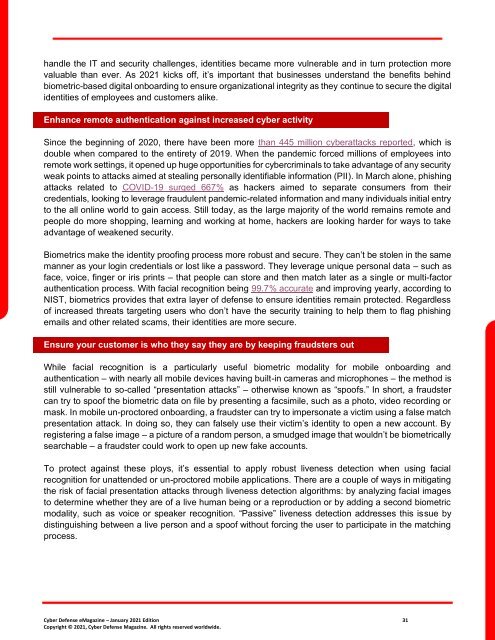Cyber Defense eMagazine January 2021 Edition
Cyber Defense eMagazine January Edition for 2021 #CDM #CYBERDEFENSEMAG @CyberDefenseMag by @Miliefsky a world-renowned cyber security expert and the Publisher of Cyber Defense Magazine as part of the Cyber Defense Media Group as well as Yan Ross, US Editor-in-Chief, Pieruligi Paganini, Co-founder & International Editor-in-Chief, Stevin Miliefsky, President and many more writers, partners and supporters who make this an awesome publication! Thank you all and to our readers! OSINT ROCKS! #CDM #CDMG #OSINT #CYBERSECURITY #INFOSEC #BEST #PRACTICES #TIPS #TECHNIQUES
Cyber Defense eMagazine January Edition for 2021 #CDM #CYBERDEFENSEMAG @CyberDefenseMag by @Miliefsky a world-renowned cyber security expert and the Publisher of Cyber Defense Magazine as part of the Cyber Defense Media Group as well as Yan Ross, US Editor-in-Chief, Pieruligi Paganini, Co-founder & International Editor-in-Chief, Stevin Miliefsky, President and many more writers, partners and supporters who make this an awesome publication! Thank you all and to our readers! OSINT ROCKS! #CDM #CDMG #OSINT #CYBERSECURITY #INFOSEC #BEST #PRACTICES #TIPS #TECHNIQUES
You also want an ePaper? Increase the reach of your titles
YUMPU automatically turns print PDFs into web optimized ePapers that Google loves.
handle the IT and security challenges, identities became more vulnerable and in turn protection more<br />
valuable than ever. As <strong>2021</strong> kicks off, it’s important that businesses understand the benefits behind<br />
biometric-based digital onboarding to ensure organizational integrity as they continue to secure the digital<br />
identities of employees and customers alike.<br />
Enhance remote authentication against increased cyber activity<br />
Since the beginning of 2020, there have been more than 445 million cyberattacks reported, which is<br />
double when compared to the entirety of 2019. When the pandemic forced millions of employees into<br />
remote work settings, it opened up huge opportunities for cybercriminals to take advantage of any security<br />
weak points to attacks aimed at stealing personally identifiable information (PII). In March alone, phishing<br />
attacks related to COVID-19 surged 667% as hackers aimed to separate consumers from their<br />
credentials, looking to leverage fraudulent pandemic-related information and many individuals initial entry<br />
to the all online world to gain access. Still today, as the large majority of the world remains remote and<br />
people do more shopping, learning and working at home, hackers are looking harder for ways to take<br />
advantage of weakened security.<br />
Biometrics make the identity proofing process more robust and secure. They can’t be stolen in the same<br />
manner as your login credentials or lost like a password. They leverage unique personal data – such as<br />
face, voice, finger or iris prints – that people can store and then match later as a single or multi-factor<br />
authentication process. With facial recognition being 99.7% accurate and improving yearly, according to<br />
NIST, biometrics provides that extra layer of defense to ensure identities remain protected. Regardless<br />
of increased threats targeting users who don’t have the security training to help them to flag phishing<br />
emails and other related scams, their identities are more secure.<br />
Ensure your customer is who they say they are by keeping fraudsters out<br />
While facial recognition is a particularly useful biometric modality for mobile onboarding and<br />
authentication – with nearly all mobile devices having built-in cameras and microphones – the method is<br />
still vulnerable to so-called “presentation attacks” – otherwise known as “spoofs.” In short, a fraudster<br />
can try to spoof the biometric data on file by presenting a facsimile, such as a photo, video recording or<br />
mask. In mobile un-proctored onboarding, a fraudster can try to impersonate a victim using a false match<br />
presentation attack. In doing so, they can falsely use their victim’s identity to open a new account. By<br />
registering a false image – a picture of a random person, a smudged image that wouldn’t be biometrically<br />
searchable – a fraudster could work to open up new fake accounts.<br />
To protect against these ploys, it’s essential to apply robust liveness detection when using facial<br />
recognition for unattended or un-proctored mobile applications. There are a couple of ways in mitigating<br />
the risk of facial presentation attacks through liveness detection algorithms: by analyzing facial images<br />
to determine whether they are of a live human being or a reproduction or by adding a second biometric<br />
modality, such as voice or speaker recognition. “Passive” liveness detection addresses this issue by<br />
distinguishing between a live person and a spoof without forcing the user to participate in the matching<br />
process.<br />
<strong>Cyber</strong> <strong>Defense</strong> <strong>eMagazine</strong> – <strong>January</strong> <strong>2021</strong> <strong>Edition</strong> 31<br />
Copyright © <strong>2021</strong>, <strong>Cyber</strong> <strong>Defense</strong> Magazine. All rights reserved worldwide.


















